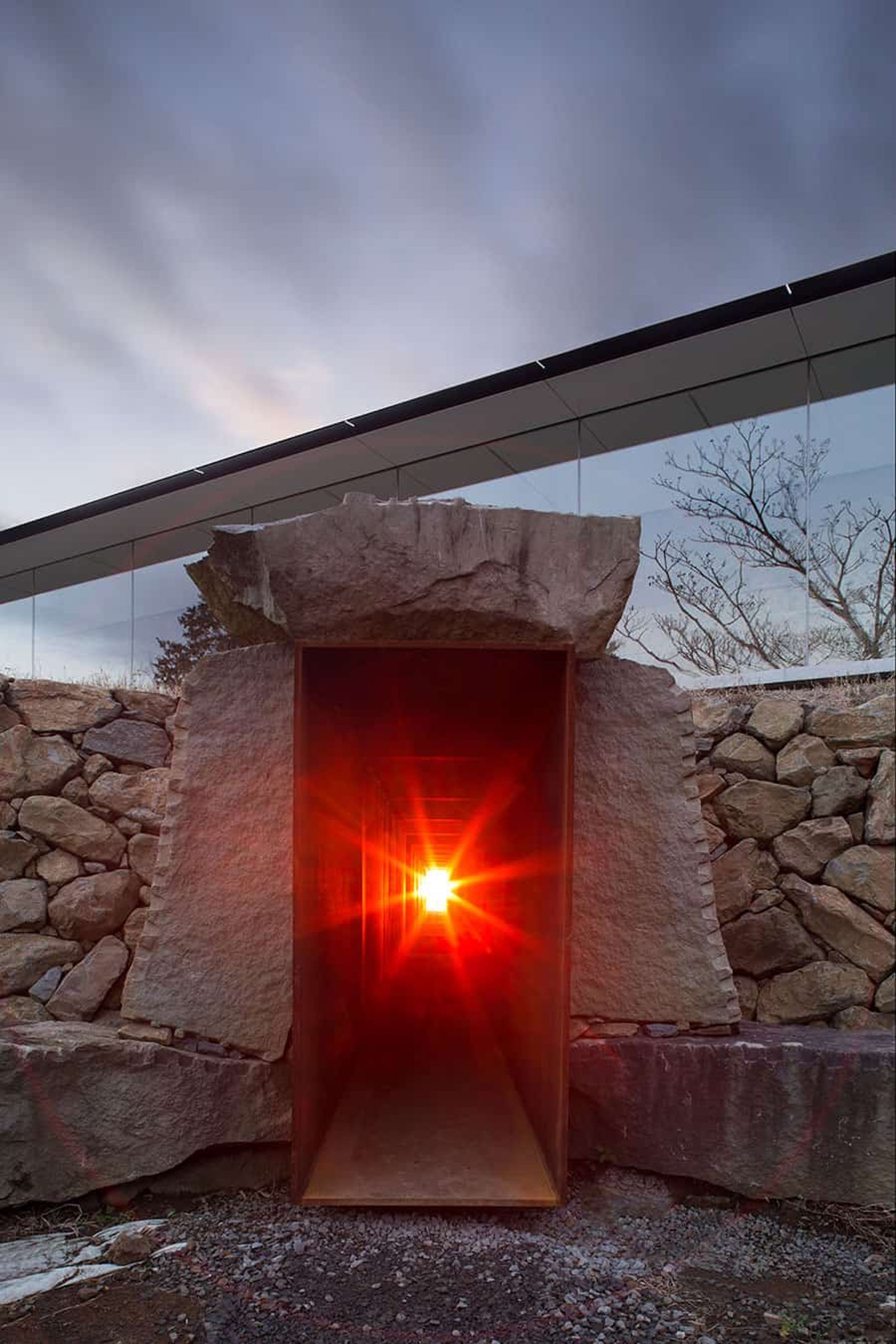
Hiroshi Sugimoto’s Summer Solstice Observation Gallery, Enoura Observatory, Japan
Hiroshi Sugimoto has designed a new complex for the Odawara Art Foundation, a non-profit Sugimoto established in 2009. The prolific photographer continues to expand his artistic practice through conceptual experimentation with memory, time, light and space beyond film. For Sugimoto, each medium serves as a tool to describe a conceptual vision, whether it is realized through photography, installation, architecture or theater. Expected to open in October 9, 2017, after over 10 years of planning, the Enoura Observatory for the Odawara Art Foundation is Sugimoto’s greatest architectural triumph to date. The complex includes exhibition spaces, a Tensho-an tea ceremony room, two Noh stages, a Muromachi Period (c. 1338-1573) Meigetsu Gate, a garden and a 70-meter long sea-facing tunnel that aligns with the sun’s position during the winter solstice.
The complex will also house the offices of the Odawara Art Foundation, establishing a site for artistic inquiry of the material, structural and philosophical traditions of the past. While devoted to ancient Japanese ideas and techniques, Sugimoto’s focus is clearly on the future; placing art at the center of the development of human civilization to envision a mindful understanding of consciousness and our lives in relation to the natural world.
The exercise of designing the complex seems as meaningful as its striking result. Sugimoto has married a breadth of natural and industrial materials with centuries-old Japanese building techniques. Steel and stone anchor the pristine pieces of glass that line the 100-meter long galleries, echoed by the floating Noh stage that is propped up by a deceivingly simple wooden support structure. Featuring materials such as Oya volcanic rock and Cor-Ten steel, he orchestrates a beautiful array of contrasting textures and building methods that are both medieval and strikingly contemporary. He aims to create an experience of traditional Japanese culture, landscape, and philosophy in a stunningly modern frame.
Hiroshi Sugimoto’s ambitious plunge into architecture is by no means sudden. His recent projects include the Izu Photo Museum and Christie’s Tokyo office, as well as the founding of the New Material Research Laboratory with architect Tomoyuki Sakakida in 2008. The Odawara Art Foundation complex is the first of several of Sugimoto’s architectural ventures that has been designed entirely from the inside out.

Winter Solstice Observation Tunnel
The 9,500 square meter site overlooks Sagami Bay and sits next to the Hakone Mountains in the Katuara district of Odawara. A stunning setting for the Observatory, the location represents a traditional Japanese approach to living in harmony with nature that dates back to the Jōmon period. Yet, this once-bustling area is now a sleepy town with a large retiree population. Odawara and the Itabashi district are known for generations of skilled craftsmen with sophisticated building techniques. Sugimoto aims to preserve and feature these methods in the Enoura Observatory complex, standing amongst the pristine landscape of the mountains and the bay, a dynamic site of beauty and powerful history.
“What if the Tokugawa shogunate had selected Odawara as its base of power instead of Edo?” asks Sugimoto. “If he had chosen it, today Odawara would be the capital of Japan, a thicket of skyscrapers rivaling Manhattan or Hong Kong, and what we call “Tokyo” would be nothing more than the middling, provincial bayside city of Edo. Personally, I am glad that Ieyasu made the decision he did.”

The tip of the Summer Solstice Observation Gallery
While the Odawara Art Foundation is deeply rooted in Japanese tradition, Sugimoto aims to explore a universal human history of consciousness and the “primal force” of the search for meaning and identity that he experienced as a child when visiting the area. Born and raised in Tokyo, Sugimoto’s deep connection to the landscape has its roots in his personal past:
“When the train came out of the twin tunnels,” recalls Sugimoto, “there was the vast Pacific Ocean, extending away to a sharp horizon line that snapped my eyes wide open. In that moment I also awoke to the fact that I was me, and that I was here on this earth.”
Sugimoto’s expressed interest in ancient art and the development of human consciousness permeate his architectural design both materially and structurally. In search of purpose-driven exhibition spaces, Sugimoto has continued to define and set standards for the high quality atmospheric experience of art through his design projects and writing. Now, the photographer and architect has theorized a universal connection to land, sea and traditional Japanese culture through primordial spirituality. In designing the Enoura Observatory, Sugimoto approaches architecture as multi-disciplinary land art.

Optical Glass Stage
“While Odawara was passed over in favor of Tokyo as the site of Japan’s capital, Odawara has the potential to be the capital of communication of our culture to the world” says Sugimoto.
Hiroshi Sugimoto has once again created a dynamic masterpiece of light and space, continuing to expand his vision beyond photography into the built environment. Finding poignant meaning in Japan’s historical relationship to nature within its architectural history, Sugimoto’s design is a triumph not only for architecture, but also for the global environmental struggle. In conceiving the Enoura Observatory, he has taken a step towards the future of cultural exchange that prioritizes the urgency of reevaluating humanity’s relationship with the natural environment and the role that art may play within it.
Sugimoto has set an example of respect for nature and history through an exquisite frame of Japanese culture. The Enoura Observatory celebrates the magic of visual and performing arts as they are paired with spectacular built and natural environments. Vocal about the “grim world of rampant materialism and consumerism,” Sugimoto envisions Odawara as a site for international cultural and environmental connection that prioritizes experience over object. In this sense, the foundation is not simply a site for preserving and exhibiting Japanese culture; rather, it is encouraging contemporary re-visitation of humanity’s relationship to the natural world.